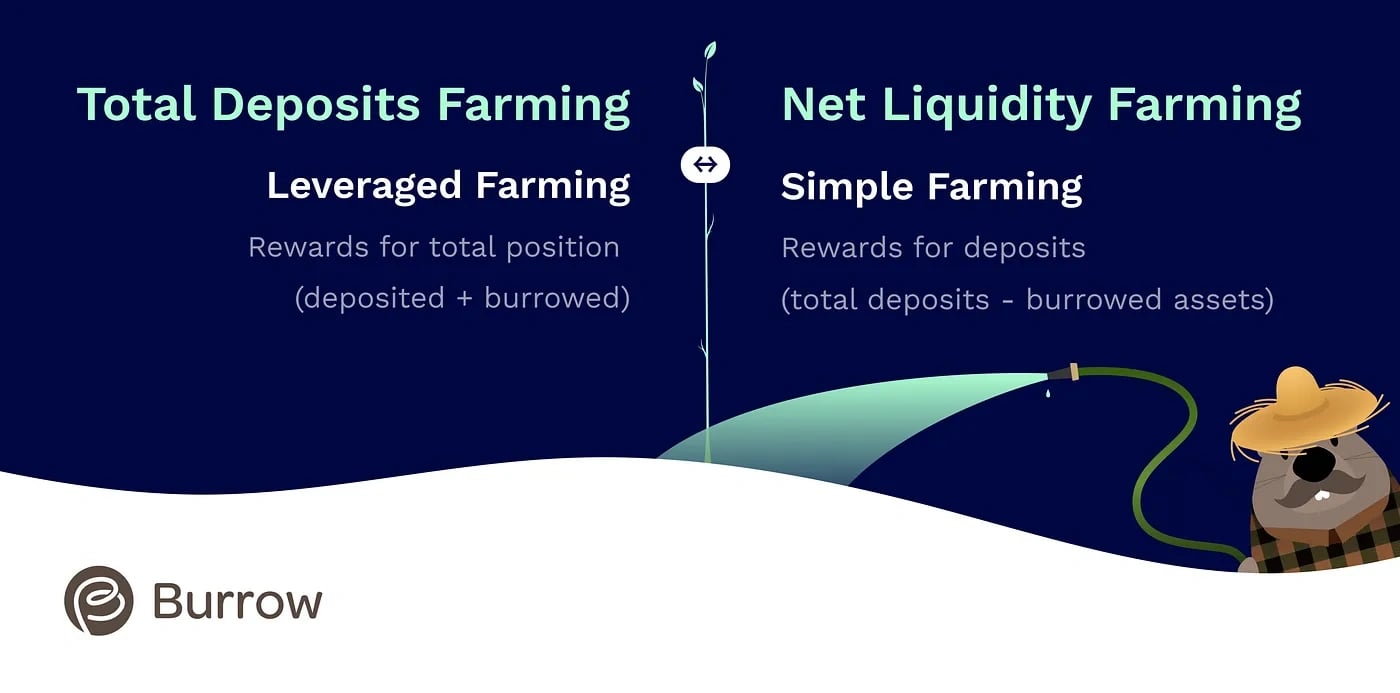Subscribe to wiki
Share wiki
Bookmark
Burrow Finance
The Agent Tokenization Platform (ATP):Build autonomous agents with the Agent Development Kit (ADK)
Burrow Finance
Burrow Finance (now rebranded as Rhea Finance) was a decentralized, non-custodial interest rates platform on the NEAR blockchain, allowing users to supply assets to earn interest and borrow against them for liquidity.
In February 2025, a merger between Burrow and Ref Finance was established to form Rhea Finance. [16] [17]
Overview
Burrow was a decentralized, non-custodial, pool-based interest rates platform where users can supply assets to earn interest and borrow against them to unlock liquidity, similar to Aave and Compound. It operates natively on the NEAR blockchain, a layer 1 proof-of-stake, sharded blockchain with a WebAssembly runtime, and its smart contracts are written in Rust. Burrow focused on unlocking liquidity for interest-bearing assets, especially layer 1 staking derivatives like stNEAR and stETH. Users can deposit stNEAR as collateral to borrow more NEAR for a leveraged staking position or borrow a stablecoin to create a self-repaying position. [2]
Burrow V2
In July 2024, Burrow Finance revealed a V2 update that introduced margin trading, allowing users to take leveraged positions and supports using Liquidity Provider (LP) tokens as collateral. These features aim to broaden DeFi activities within the NEAR ecosystem. The protocol leverages its native asset, $BRRR, and is working on cross-chain functionalities through Chain Abstraction for interaction with other blockchain networks. Burrow's lending and borrowing services complement other DeFi protocols on NEAR, enhancing the range of financial tools available to users.
Burrow's Merger with Ref Finance to form Rhea Finance
Ref Finance and Burrow Finance merged in February 2025 to create the next generation of chain-abstracted liquidity platforms, Rhea Finance. [17]
This was said to be done for the betterment of decentralized finance as a whole. The two sides came together to combat the challenge of fragmentation. [18]
The industry currently requires users to navigate different chains, platforms, and wallets to access liquidation and optimize their yield strategies. However, Ref and Burrow created Rhea Finance to solve this problem. [17] [18]
Features
Health Factor
Users can borrow against their supplied assets, with all positions requiring over-collateralization. The Health Factor represents the borrowed assets' combined collateral ratios, indicating a position's risk. Computed per account, not per asset, the Health Factor considers each asset's collateral factor, which reflects its price stability. A higher collateral factor indicates greater expected price stability. The account is in good standing if the Health Factor exceeds 100% and cannot be liquidated. If it falls below 100%, the account can be partially liquidated and cannot borrow more without repaying existing assets or providing additional collateral. [4]
Liquidations
A liquidation is triggered when an account's Health Factor drops below 100%, indicating insufficient collateral value to cover the debt. This can occur if the collateral decreases or the borrowed debt increases. Burrow's liquidation mechanism encourages competition among liquidators by offering variable discounts and liquidation sizes, minimizing losses for unhealthy accounts. [5]
Liquidations follow three basic rules: the initial Health Factor of the liquidated accounts must be below 100%; the discounted sum of the taken collateral must be less than the sum of repaid assets; and the final Health Factor of the liquidated accounts must remain below 100%. These rules ensure that only unhealthy accounts are liquidated, prevent taking excessive collateral, and restrict liquidators from repaying too much of the borrowed assets, maintaining the Health Factor close to 100%. [5]
Price Oracle
Burrow uses a MakerDAO-inspired whitelisted oracle, currently operated by five independent operators and designed to be easily extended into a decentralized, self-sustainable network. For a price to be reported on-chain, most oracles must propose the current price within a tight range, ensuring its relevance is less than one minute. The DAO plans to consider adding other robust Oracle solutions supported on NEAR, such as Flux, in the future. [6]
Pyth Oracle
The Pyth Network is a first-party financial data oracle network that securely delivers low-latency price data for various assets to blockchains. The protocol aggregates data providers' inputs to produce a single aggregate price and confidence interval every 400ms for each price feed, managed on an application-specific blockchain called Pythnet. It features a novel Pull Oracle architecture, allowing data users to request price updates from the Pyth protocol as needed. [6]
Net Liquidity Farming
On July 12th, Burrow transitioned from a “total deposits farming” model to a “net liquidity farming” model. Under the new system, global rewards were distributed based on “net liquidity,” the amount deposited minus borrowed assets, rather than total deposits. This change impacted global rewards like $USN but not pool-specific rewards such as $liNEAR or $META, which continued as before. Users needed to review the updates to understand the potential effects on their rewards. Net liquidity farming aimed to optimize the use of Burrow’s treasury and align rewards with actual usage. The Burrow DAO adjusted the reward models, including boosting global rewards or adding new assets based on market conditions and user behavior. [7]

Products
Supplying
Users can supply assets to the protocol and immediately start earning passive interest, which varies based on the asset's utilization rate. Withdrawals are allowed anytime, provided the asset's utilization rate remains below 100% post-withdrawal. If the withdrawal raises the utilization rate to 100%, it will be temporarily unavailable, creating an expensive situation for borrowers and a lucrative one for suppliers. Users can designate a percentage of their supplied assets as collateral, subject to liquidation, while non-collateral assets will continue to accrue interest. This designation can be managed at any time. [8]
Borrowing
Users can borrow against their supplied assets on Burrow, with all positions requiring over-collateralization. If the value of a user's collateral falls below the minimum collateral ratio, their collateral will be liquidated to cover the debt. Each asset has a unique minimum collateral ratio due to varying risk levels, which can be referenced on the platform. The overall risk of an account is indicated by the Health Factor, reflecting the combined collateral ratios of the borrowed assets. A Health Factor above 100% means the account is safe from liquidation, while a factor below 100% indicates the account can be partially liquidated and cannot borrow more without repaying some debt or adding more collateral. [9]
Assets
Burrow supports 13 assets for supplying and 12 assets for borrowing. The Burrow DAO votes to enable new assets deemed safe to list, focusing on interest-bearing assets, including L1 staking derivatives like Staked NEAR. Prospective assets must be trustless, sufficiently liquid on NEAR DEXs and other markets, and broadly distributed. Current supported assets include: [10]
APY
Annual Percentage Yield (APY) is the compounding interest on a deposit or loan after a year, calculated based on the initial principal. Each Burrow asset has its supply and demand market, with its evolving APY. Supply APY is the current interest APY of the asset when supplied, and borrow APY is the current interest APY of the asset when borrowed. Each asset has different parameters that determine its actual yield at different points. Users may receive liquidity mining rewards like BRRR, USN, or other tokens when supplying or borrowing, potentially increasing the actual APY. Liquidity mining rewards are assessed and distributed on two levels: [11]
- Pool-specific rewards: Some asset pools on Burrow offer additional rewards on top of the base APY for suppliers and/or borrowers.
- Net liquidity rewards: Rewards are based on net liquidity across all asset pools. For example, if a user supplies $100 worth of USDC and borrows $50 worth of wNEAR, their net liquidity is $50, and they earn rewards based on that amount.
Burrow users can earn yields from base APY, pool-specific, and net-liquidity rewards. Liquidity mining rewards are distributed among participants based on their number of shares. BRRR token holders can participate in the BRRR staking program to boost their shares and receive more reward tokens. [11]
Burrow DAO
Burrow is governed by the Burrow DAO, using the SputnikDAO/AstroDAO framework. This system allows for flexible role creation with encoded responsibilities and execution of any transactions supported by the NEAR blockchain. The DAO manages the treasury, reserve funds, onboarding new assets, and managing asset risks through various parameters. [12]
The DAO has two roles: the Council and the Community Board. The Council, consisting of 5 members, can submit and vote on proposals. The Community Board, with 15 members, can vote on proposals. The Council submits proposals, and the Community Board votes to approve or reject them. Sometimes, the Council will submit proposals for the Community Board or the broader Burrow community. If an approved proposal requires complex actions involving multiple transactions, the Council will create and approve proposals to execute those actions. [12]
In the future, once a substantial portion of BRRR tokens are distributed, the DAO will add the Token Holder role, which is expected to replace the Community Board for approving or rejecting proposals. Token Holders can also add and remove Council and Community Board members; additional roles with various permissions can be created. [12]
BRRR Token
BRRR is Burrow's native governance token. Most of the token supply will be distributed to active users and community members. For the first 4 weeks, BRRR will be non-transferrable from the Burrow app until the DAO votes to allow transfers. This initial period helps Burrow align with early users and supporters. BRRR holders can participate in the BRRR staking program to stake BRRR and receive xBRRR tokens. [13]
Tokenomics

BRRR has a total supply of 1B tokens and has the following distribution: [13]
- Community: 50%
- DAO Treasury: 20%
- Core Team: 20%
- Strategic Investors: 10%
Up to 6% of the BRRR supply (60,000,000 BRRR) will be distributed to the Burrow community in the first three months after launch. [13]
Staking
BRRR token holders can participate in a staking program similar to Curve's ve-token model. By staking BRRR tokens, users receive xBRRR tokens, which offer boosted rewards for supplying and borrowing on Burrow and allow participation in DAO governance through voting. The staking period ranges from 30 to 90 days, with longer staking periods yielding more xBRRR. xBRRR tokens enhance liquidity mining rewards and can be used to boost shares in asset pools. At the end of the lockup period, xBRRR tokens are burned, and users receive their staked BRRR back. xBRRR tokens are non-transferable and remain within users' accounts. [14][15]
Partnerships
See something wrong?
The Agent Tokenization Platform (ATP):Build autonomous agents with the Agent Development Kit (ADK)
